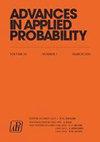回火稳定过程极值的蒙特卡罗算法
IF 1.2
4区 数学
Q3 STATISTICS & PROBABILITY
引用次数: 3
摘要
我们为由上确界、达到上确界的时间和指数调和Lévy过程在给定(恒定)时间的位置组成的向量开发了一种新的蒙特卡罗算法。该算法基于无回火过程的增量,对于向量的不连续和局部Lipschitz函数,具有几何快速收敛性(作为计算成本的函数)。我们证明了相应的多级蒙特卡罗估计器具有最优计算复杂度(即,如果均方误差至多为$\varepsilon^2$,则为$\varepsilon^{-2}$阶),并提供了其中心极限定理(CLT)。使用CLT,我们在基于真实世界数据校准/估计的调和稳定(CGMY)模型下,基于下降构建了屏障期权价格和各种风险度量的置信区间。我们提供了我们的算法与现有近似的非渐近和渐近比较,从而得出经验法则,指导用户为给定的参数集选择最佳方法。我们用数值例子说明了该算法的性能。本文章由计算机程序翻译,如有差异,请以英文原文为准。
A Monte Carlo algorithm for the extrema of tempered stable processes
We develop a novel Monte Carlo algorithm for the vector consisting of the supremum, the time at which the supremum is attained, and the position at a given (constant) time of an exponentially tempered Lévy process. The algorithm, based on the increments of the process without tempering, converges geometrically fast (as a function of the computational cost) for discontinuous and locally Lipschitz functions of the vector. We prove that the corresponding multilevel Monte Carlo estimator has optimal computational complexity (i.e. of order
$\varepsilon^{-2}$
if the mean squared error is at most
$\varepsilon^2$
) and provide its central limit theorem (CLT). Using the CLT we construct confidence intervals for barrier option prices and various risk measures based on drawdown under the tempered stable (CGMY) model calibrated/estimated on real-world data. We provide non-asymptotic and asymptotic comparisons of our algorithm with existing approximations, leading to rule-of-thumb principles guiding users to the best method for a given set of parameters. We illustrate the performance of the algorithm with numerical examples.
求助全文
通过发布文献求助,成功后即可免费获取论文全文。
去求助
来源期刊

Advances in Applied Probability
数学-统计学与概率论
CiteScore
2.00
自引率
0.00%
发文量
64
审稿时长
6-12 weeks
期刊介绍:
The Advances in Applied Probability has been published by the Applied Probability Trust for over four decades, and is a companion publication to the Journal of Applied Probability. It contains mathematical and scientific papers of interest to applied probabilists, with emphasis on applications in a broad spectrum of disciplines, including the biosciences, operations research, telecommunications, computer science, engineering, epidemiology, financial mathematics, the physical and social sciences, and any field where stochastic modeling is used.
A submission to Applied Probability represents a submission that may, at the Editor-in-Chief’s discretion, appear in either the Journal of Applied Probability or the Advances in Applied Probability. Typically, shorter papers appear in the Journal, with longer contributions appearing in the Advances.
 求助内容:
求助内容: 应助结果提醒方式:
应助结果提醒方式:


